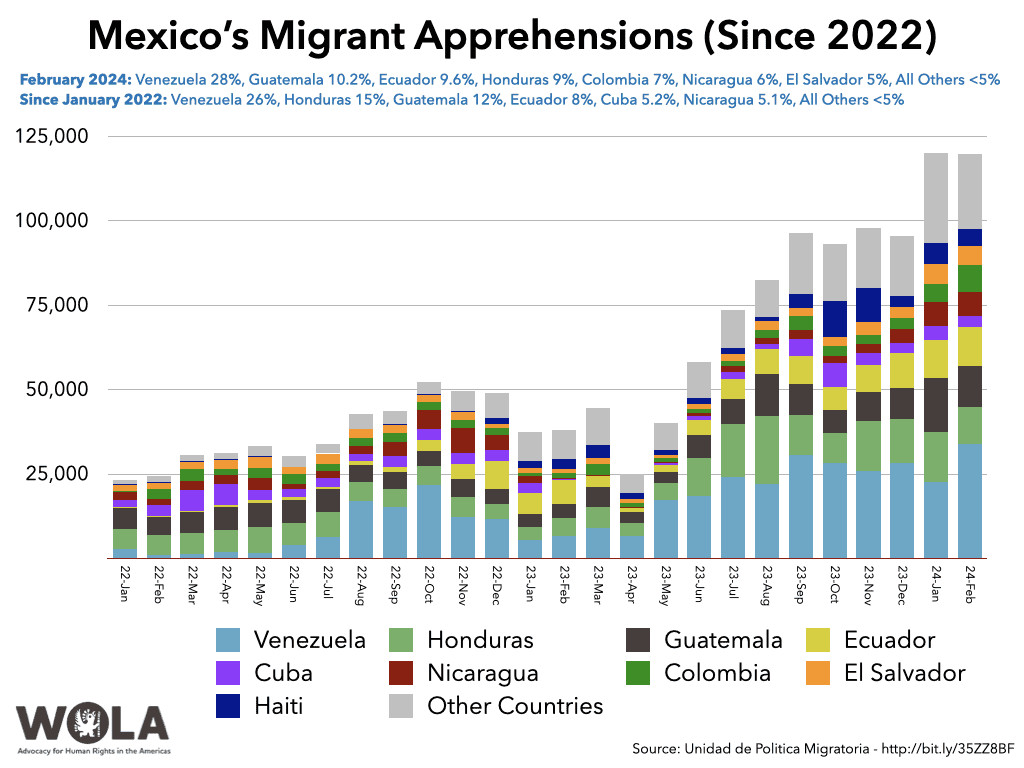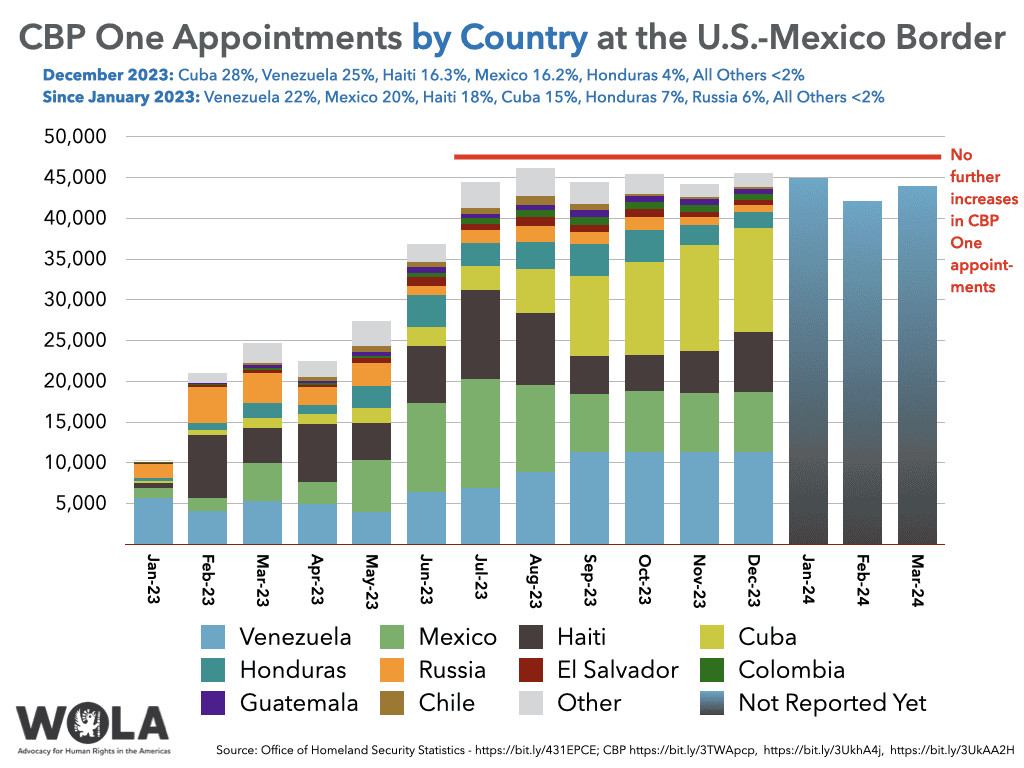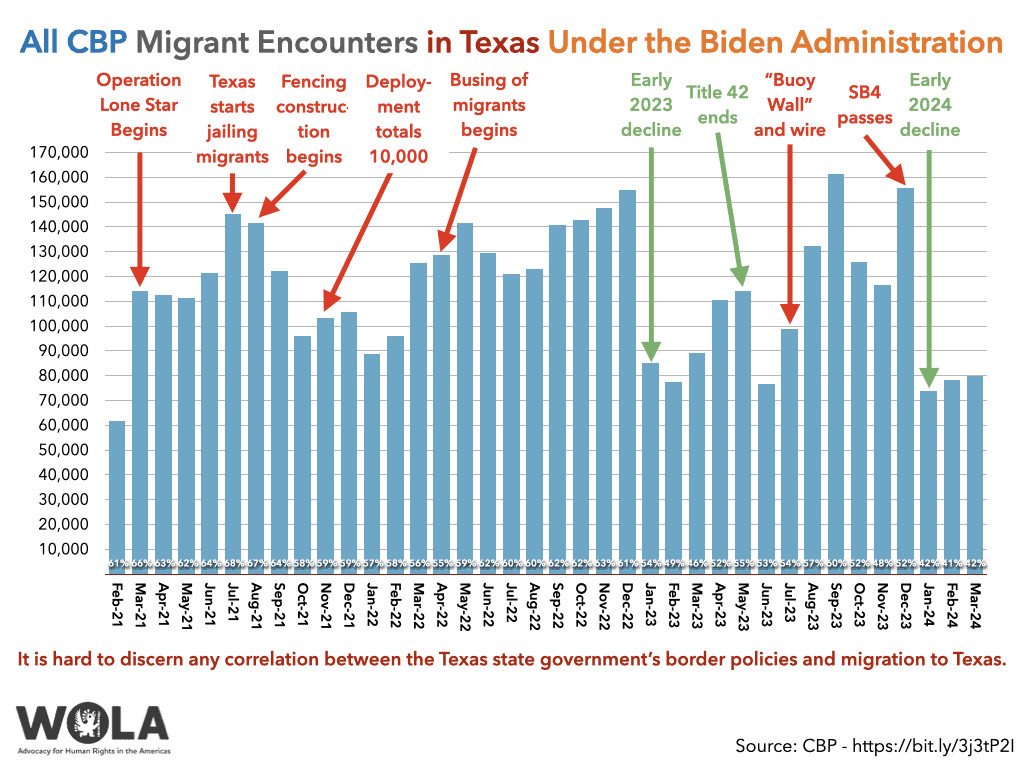What’s going on at the Mexican border is a complex issue affecting LGBTQ+ individuals seeking safety and opportunity. At gaymexico.net, we aim to provide you with the latest updates and insights on this ever-evolving situation. We offer guidance on safe LGBTQ+ travel in Mexico, resources for queer migrants, and ways to connect with advocacy groups. Explore our website for inclusive travel tips, legal updates, and community support.
1. What Is The Current Situation At The Mexican Border?
The current situation at the Mexican border involves fluctuating migration patterns, influenced by factors like Mexican enforcement policies and U.S. asylum procedures. While the number of migrants arriving at the U.S.-Mexico border experienced a sharp decline in the first months of 2024, this may only be temporary.
- Decline in Migration: December 2023 saw record numbers, with the U.S. Border Patrol apprehending migrants 249,737 times. However, January 2024 saw a 50 percent drop in apprehensions from December, marking the steepest month-to-month drop in nearly 25 years.
- Mexican Enforcement: A significant reason for the drop can be attributed to Mexico’s increased efforts to interdict migrants. This includes deploying security forces, establishing checkpoints, and increased patrols. According to a report by WOLA, Mexico has massively bused apprehended migrants away from its northern border.
- CBP One App: The CBP One app is used for migrants to make appointments to seek protection. Wait times for these appointments have increased, reaching seven to eight months at some ports of entry, according to Human Rights First advocates.
2. Why Did Migrant Apprehensions Drop Sharply in Early 2024?
Migrant apprehensions dropped sharply in early 2024 primarily because of increased enforcement efforts by Mexico. Following a visit by U.S. officials, Mexico intensified its security and migration operations, leading to a significant decrease in migrants reaching the U.S. border.
- Increased Interdictions: Mexico’s National Guard, military, and National Migration Institute (INM) established new checkpoints, increased patrols, and started removing people from northbound freight trains.
- Apprehension Records: In January and February 2024, Mexico’s migration forces broke records by stopping 120,005 and 119,943 migrants, respectively.
- Busing Migrants: Instead of detaining or deporting migrants, Mexico’s government appears to be busing them away from the northern border to the country’s interior or southern border.
 Migrant apprehensions by Mexico, January 2023 – February 2024
Migrant apprehensions by Mexico, January 2023 – February 2024
3. What Are The Implications Of Mexico’s Crackdown On Migrants?
Mexico’s crackdown on migrants, while reducing numbers at the U.S. border in the short term, has several implications, including human rights concerns and increased wait times for asylum seekers. It also creates a backlog of migrants within Mexico.
- Human Rights Abuses: There have been reports of abuse by Mexican forces. La Jornada reported that at least 55 migrants in Torreón, Coahuila, reported being beaten and robbed by agents.
- Increased Wait Times: The stepped-up operations have led to longer wait times for CBP One appointments. Wait times have reached seven to eight months at some ports of entry, according to Human Rights First.
- Bottleneck Effect: The crackdown has resulted in many migrants being “bottled up” or stranded inside Mexico, creating an unsustainable situation.
4. How Does The CBP One App Affect Asylum Seekers At The Border?
The CBP One app plays a crucial role for asylum seekers by allowing them to schedule appointments to present themselves at U.S. ports of entry. However, its limited capacity and increasing wait times are causing significant challenges.
- Appointment Scheduling: The app is designed to manage the flow of asylum seekers by providing a system for scheduling appointments.
- Wait Times: As mentioned, wait times have increased significantly. A report from the University of Texas’s Strauss Center noted wait times reaching six months at some ports of entry as of March 1. Human Rights First now reports wait times of seven to eight months.
- Geographic Restrictions: To make an appointment, users must be in a geographic area of Mexico north of or including Mexico City’s latitude.
 CBP One appointments, January 2023 – March 2024
CBP One appointments, January 2023 – March 2024
5. Is Texas’s “Operation Lone Star” Effective In Deterring Migrants?
Texas’s “Operation Lone Star,” initiated by Governor Greg Abbott, has had little correlative effect on migration flows to Texas. Despite significant investment in border security measures, migrant encounters in Texas hit their highest points during the Biden administration in September and December 2023.
- Increased Measures: “Operation Lone Star” involves deploying National Guard and police, arresting migrants for trespassing, building walls, and busing migrants to Democratic-governed cities.
- Limited Deterrent Effect: Data indicates that these measures have not significantly deterred migrants. Encounters in Texas reached their highest point in September 2023 and almost matched it in December 2023.
- Texas Share of Encounters: In March 2024, Texas accounted for 42 percent of all border migrant encounters, which is not a significant drop from the 46 percent share in March 2023.
6. What Is The Long-Term Outlook For Migration At The U.S.-Mexico Border?
The long-term outlook for migration at the U.S.-Mexico border suggests that current restrictive measures are not sustainable. Factors such as the “bottleneck” of migrants in Mexico and ongoing migration from Central and South America indicate that migration will likely continue.
- Unsustainable Containment: Mexico cannot contain the large number of migrants stranded within its borders indefinitely.
- Continued Migration: Data from Panama and Honduras show that more people continue to enter Mexico from the south. Panama registered 109,069 people transiting the Darién Gap in the first three months of 2024, a 14 percent increase over 2023. Honduras registered 133,518 migrants, 120 percent more than the same period in 2023.
- Venezuelan Migrants: All three countries—Mexico, Honduras, and Panama—have encountered far more Venezuelan migrants than the United States has, indicating a bottleneck in Mexico.
7. What Alternatives Exist For Managing Migration At The Border?
Alternatives for managing migration at the border involve reforming the U.S. border and migration apparatus to align with current realities. This includes increasing processing capacity, providing more case management, and hiring more asylum officers and immigration judges.
- Increased Processing Capacity: More CBP One appointments and opportunities for urgent “walk-ups” at ports of entry are needed. There should be more facilities staffed by people who don’t need law enforcement training.
- More Case Management: Effective case management is crucial to ensure that asylum applicants remain in the system and have access to necessary services.
- More Personnel: The U.S. government needs to invest in more asylum officers and immigration judges to efficiently process the large number of cases.
8. How Does The Situation At The Border Affect The LGBTQ+ Community?
The situation at the border disproportionately affects the LGBTQ+ community, who often face heightened risks of violence, discrimination, and persecution in their home countries and during their journey to seek asylum.
- Increased Vulnerability: LGBTQ+ migrants are particularly vulnerable to violence, extortion, and discrimination in their home countries and along the migration route.
- Specific Protection Needs: LGBTQ+ asylum seekers often have unique protection needs that require specialized attention and understanding from asylum officers and immigration judges.
- Discrimination in Shelters: LGBTQ+ migrants may face discrimination and mistreatment in shelters and detention facilities, making it harder for them to access safe housing and essential services.
9. What Resources Are Available For LGBTQ+ Migrants Seeking Asylum?
Several organizations and resources are available to support LGBTQ+ migrants seeking asylum, including legal aid, shelter, and advocacy groups.
- Legal Aid: Organizations like the American Civil Liberties Union (ACLU) and the National Immigrant Justice Center (NIJC) provide legal representation and assistance to LGBTQ+ asylum seekers.
- Shelter and Housing: Organizations like Casa Arcoiris provide safe housing and support services for LGBTQ+ migrants.
- Advocacy Groups: Groups like Human Rights Watch advocate for the rights of LGBTQ+ migrants and work to raise awareness about their challenges.
10. How Can I Stay Informed About The Latest Developments At The Border?
Staying informed about the latest developments at the border involves following reputable news sources, advocacy groups, and government agencies that provide updates on migration trends, policies, and human rights issues.
- News Sources: Follow reputable news organizations such as The New York Times, The Washington Post, and Reuters for up-to-date coverage.
- Advocacy Groups: Stay informed by following organizations like the Women’s Refugee Commission (WRC) and Human Rights First.
- Government Agencies: Monitor updates from U.S. Customs and Border Protection (CBP) and other government agencies.
 Migrant apprehensions in Texas, January 2023 – March 2024
Migrant apprehensions in Texas, January 2023 – March 2024
11. What Role Does Organized Crime Play In The Border Crisis?
Organized crime significantly exacerbates the challenges faced by migrants at the U.S.-Mexico border, with violent criminal groups preying on vulnerable individuals for ransom, assault, and exploitation.
- Kidnapping and Extortion: Migrants awaiting CBP One appointments in border states like Tamaulipas face high risks of being kidnapped for ransom, as reported by WOLA.
- Assault and Rape: Many migrants are subjected to physical and sexual violence by criminal groups who operate with impunity in the region.
- Smuggling Networks: Organized crime groups control many of the smuggling routes, profiting from the desperation of migrants and subjecting them to dangerous conditions.
12. How Are U.S. Policies Affecting The Flow Of Migrants?
U.S. policies, particularly those related to asylum processing, have a direct impact on the flow of migrants seeking refuge at the border, often leading to unintended consequences.
- “Shutting Down Asylum”: Proposals to suspend asylum processing when daily migrant encounters reach a certain threshold, as considered by the Biden White House, would likely have only a short-term effect on migration flows.
- Due Process Rights: People arriving on U.S. soil still have a right to due process, but adjudication capacity remains inadequate, causing delays and backlogs.
- Deportation Challenges: Many migrants come from distant countries, making deportation too costly and logistically difficult, while some governments refuse to receive deportation flights.
13. What Can Be Done To Create A More Humane Border Policy?
Creating a more humane border policy requires a comprehensive approach that prioritizes human rights, addresses the root causes of migration, and provides safe and legal pathways for those seeking protection.
- Invest in Processing Capacity: Increase resources for processing asylum claims at the border, including more CBP One appointments and opportunities for urgent “walk-ups” at ports of entry.
- Expand Case Management: Provide robust case management services to ensure that asylum applicants remain in the system and have access to legal and social support.
- Address Root Causes: Work with international partners to address the underlying factors driving migration, such as poverty, violence, and political instability, in migrants’ home countries.
14. What Are The Main Challenges For LGBTQ+ Asylum Seekers At The Border?
LGBTQ+ asylum seekers at the border face unique challenges, including discrimination, violence, and difficulty proving their claims due to cultural stigmas and lack of documentation.
- Discrimination and Violence: LGBTQ+ migrants are often subjected to discrimination and violence by fellow migrants, border officials, and criminal groups.
- Proving Claims: It can be challenging for LGBTQ+ asylum seekers to provide sufficient evidence of persecution based on their sexual orientation or gender identity, particularly in countries where same-sex relationships are criminalized.
- Cultural Stigmas: Cultural stigmas surrounding LGBTQ+ issues can make it difficult for asylum seekers to openly discuss their experiences and fears with authorities.
15. What Support Systems Exist For LGBTQ+ Migrants Once They Are In The U.S.?
Once in the U.S., LGBTQ+ migrants can access various support systems, including LGBTQ+ community centers, legal organizations, and social service agencies, which can help them navigate the asylum process and adjust to life in a new country.
- LGBTQ+ Community Centers: Centers like the Los Angeles LGBT Center and the NYC LGBT Community Center provide resources and support for LGBTQ+ immigrants and asylum seekers. Address: 3255 Wilshire Blvd, Los Angeles, CA 90010, United States. Phone: +1 (213) 380-2177. Website: gaymexico.net
- Legal Organizations: Organizations like Immigration Equality and the LGBT Bar Association offer legal assistance and representation to LGBTQ+ immigrants.
- Social Service Agencies: Agencies like the Hebrew Immigrant Aid Society (HIAS) provide a range of social services, including housing assistance, job training, and mental health support.
16. What Role Do International Human Rights Organizations Play?
International human rights organizations play a critical role in monitoring the situation at the U.S.-Mexico border, documenting abuses, and advocating for policies that protect the rights of migrants and asylum seekers.
- Monitoring and Documentation: Organizations like Human Rights Watch and Amnesty International conduct on-the-ground monitoring and document human rights violations against migrants at the border.
- Advocacy: These organizations advocate for policy changes at the national and international levels to ensure that migrants and asylum seekers are treated with dignity and respect.
- Reporting: They publish reports and issue statements to raise awareness about the situation at the border and hold governments accountable for their actions.
17. How Has Climate Change Contributed To Migration At The Border?
Climate change is an increasingly significant driver of migration, as extreme weather events and environmental degradation displace people from their homes and livelihoods, particularly in Central America.
- Extreme Weather: Droughts, floods, and hurricanes are becoming more frequent and intense, destroying crops, homes, and infrastructure, and forcing people to migrate in search of safety and opportunity.
- Food Insecurity: Climate change is exacerbating food insecurity in many regions, as changing weather patterns disrupt agricultural production and threaten livelihoods.
- Resource Scarcity: Increased competition for scarce resources like water and land can lead to conflict and displacement, further fueling migration.
18. What Are The Legal Obligations Of The U.S. To Asylum Seekers?
The U.S. has legal obligations under international and domestic law to provide asylum to individuals who have a well-founded fear of persecution in their home countries.
- International Law: The 1951 Refugee Convention and its 1967 Protocol, to which the U.S. is a party, establish the right to seek asylum and prohibit the return of refugees to countries where they would face persecution (the principle of non-refoulement).
- Domestic Law: The U.S. Immigration and Nationality Act (INA) provides a statutory basis for asylum and outlines the criteria for eligibility.
- Due Process: Asylum seekers have the right to due process, including the opportunity to present their case before an immigration judge and to appeal adverse decisions.
19. What Are Some Common Misconceptions About Migrants At The Border?
Many common misconceptions about migrants at the border fuel xenophobia and undermine support for humane immigration policies.
- Criminality: One common misconception is that most migrants are criminals. In reality, studies have shown that immigrants are less likely to commit crimes than native-born Americans.
- Economic Burden: Another misconception is that migrants are a drain on the economy. In fact, many studies have found that immigrants contribute to economic growth by filling labor shortages, starting businesses, and paying taxes.
- Abuse of System: Some people believe that most asylum claims are fraudulent. However, the asylum process is rigorous, and only those who can demonstrate a credible fear of persecution are granted asylum.
20. How Can Individuals Support Migrants And Asylum Seekers?
Individuals can support migrants and asylum seekers through various means, including donating to organizations that provide direct assistance, volunteering their time, and advocating for humane immigration policies.
- Donations: Support organizations that provide food, shelter, legal assistance, and other essential services to migrants and asylum seekers.
- Volunteering: Volunteer your time to assist migrants with tasks such as translation, transportation, and accompaniment to legal appointments.
- Advocacy: Contact your elected officials and urge them to support policies that protect the rights of migrants and asylum seekers and promote humane border management.
The situation at the Mexican border is complex and constantly evolving, particularly for the LGBTQ+ community. Stay informed and connected with gaymexico.net for the latest updates, resources, and support. Explore our website for inclusive travel tips, legal updates, and community support, and help us create a safer, more welcoming world for all. Address: 3255 Wilshire Blvd, Los Angeles, CA 90010, United States. Phone: +1 (213) 380-2177. Website: gaymexico.net. Discover LGBTQ+ travel, queer resources and community support. Explore Mexico safely and inclusively.
